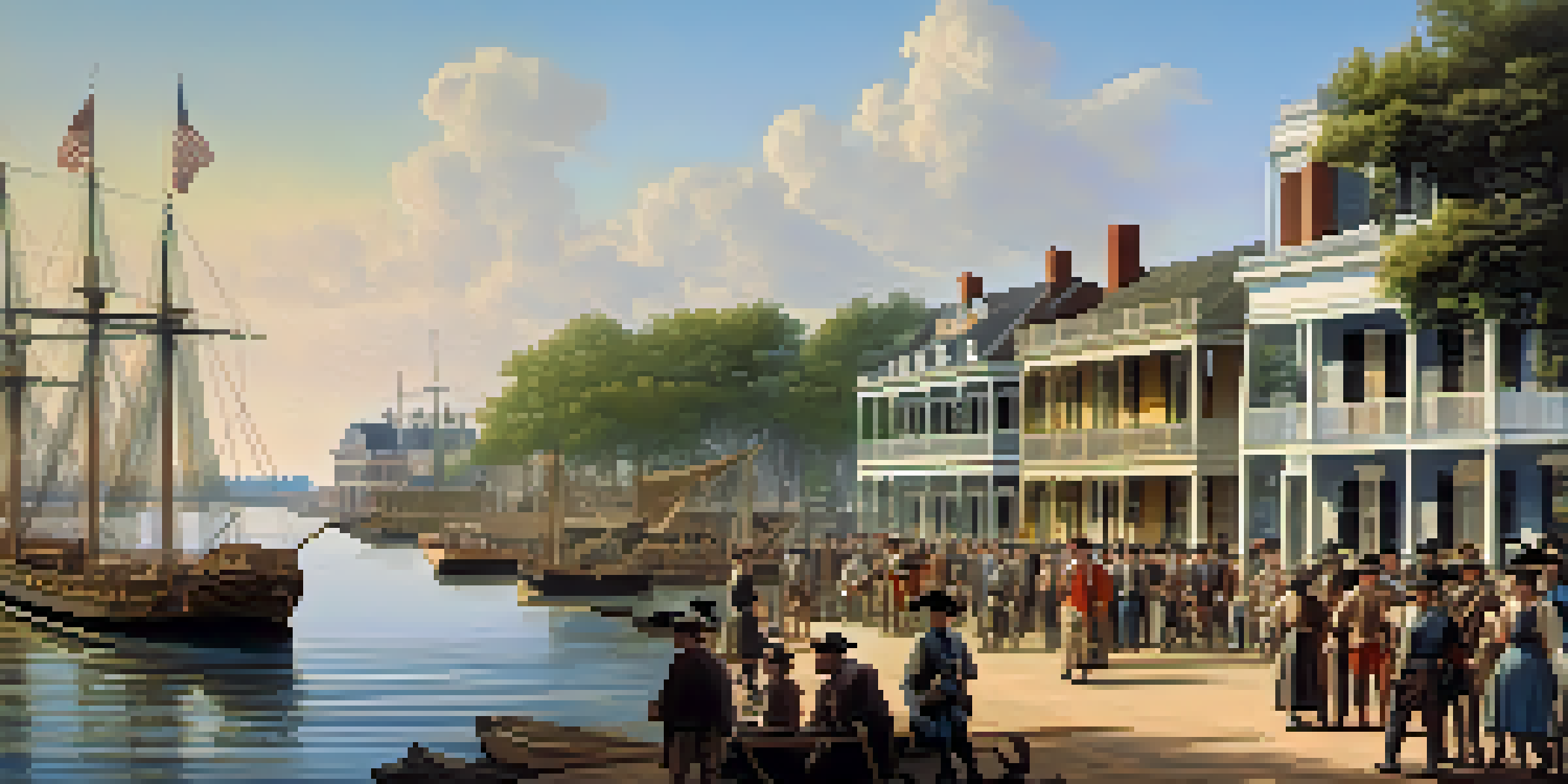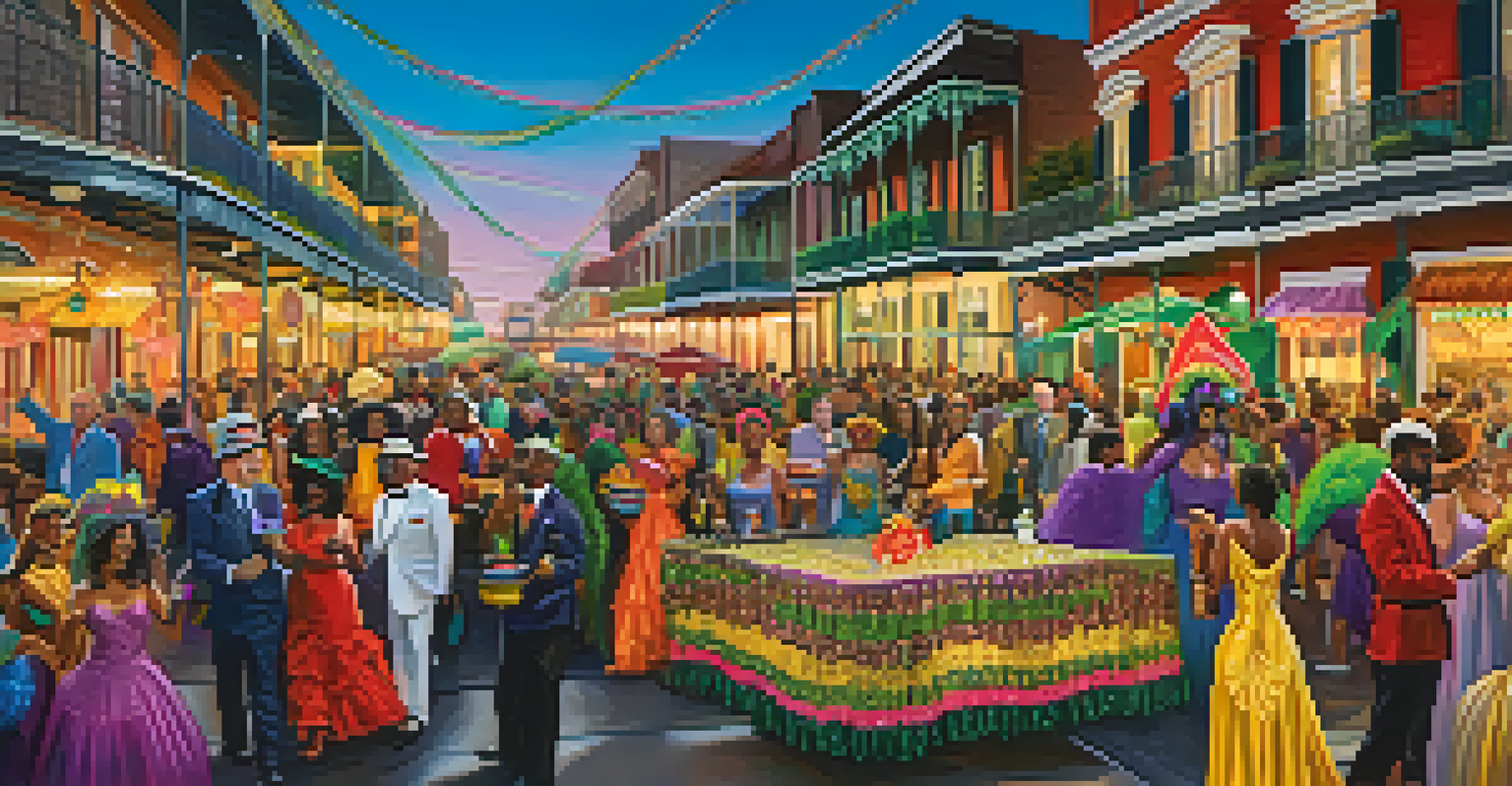The Impact of Colonial Powers on New Orleans' History

The Founding of New Orleans: A Colonial Endeavor
New Orleans was founded in 1718 by the French as part of their colonial ambitions in North America. This strategic location along the Mississippi River made it an essential trade hub, attracting settlers and traders alike. The French established a grid layout for the city, which still influences its architecture and culture today. The early days of New Orleans set the stage for a unique blend of European and indigenous influences that would define the city.
New Orleans is like a melting pot of cultures, each adding its own flavor to the city's unique identity.
The French not only brought their language and customs but also their culinary traditions, which would later evolve into the Creole cuisine beloved today. The city's early governance reflected French styles, and many of the original settlers aimed to create a society reminiscent of their homeland. This foundational period established a culture of resilience and adaptability that would become a hallmark of New Orleans.
However, the French control was short-lived, leading to a series of transitions that would further shape the city's identity. In 1763, France ceded the territory to Spain, bringing a new wave of cultural and political changes that would influence the city's future.
Spanish Rule: Transforming New Orleans' Landscape
Spanish rule began in 1763 and lasted until the early 19th century, significantly transforming New Orleans. Under Spanish governance, the city saw the construction of many significant buildings, such as the Cabildo and the St. Louis Cathedral, which still stand today. These structures showcase a blend of Spanish colonial architecture, enhancing the city's unique aesthetic and historical value.

The Spanish also implemented new regulations and economic policies that impacted trade and agriculture in the region. The introduction of the plantation system brought about profound changes, as sugar and cotton became essential exports. This economic shift led to a demographic transformation, with an influx of enslaved Africans who would shape the cultural fabric of New Orleans.
Colonial Foundations Shaped New Orleans
The early French and Spanish colonial influences established a unique cultural and architectural identity that defines New Orleans today.
This period also saw the development of a distinct social hierarchy influenced by race and class, laying the groundwork for the complex dynamics that characterize New Orleans today. The legacy of Spanish rule is still felt in the city’s vibrant festivals, traditions, and the rich tapestry of cultures that coexist.
The Louisiana Purchase: A Turning Point
In 1803, the United States acquired New Orleans through the Louisiana Purchase, marking a significant turning point in the city's history. This acquisition not only expanded U.S. territory but also signified the end of European colonial dominance in the region. New Orleans became a vital port for American commerce, further integrating the city into the national economy.
The history of New Orleans is a tapestry of cultures, woven together by the threads of colonialism and resilience.
The transition to American governance brought about changes in laws and social structures, impacting the lives of many residents. While some welcomed the changes, others resisted, leading to tensions as different cultures collided. This period also marked the beginning of a new chapter where American ideals began to influence local customs and practices.
Despite these shifts, the essence of New Orleans remained rooted in its colonial past. The blend of French, Spanish, and African influences continued to thrive, creating a unique identity that persists to this day.
Cultural Melting Pot: The Legacy of Colonialism
The impacts of colonial powers have made New Orleans one of the most culturally diverse cities in the United States. The interplay between French, Spanish, and African traditions has resulted in a unique fusion that can be seen in the city's music, food, and festivals. For example, jazz music, which has roots in African rhythms and European harmonies, emerged as a defining genre in New Orleans.
Culinary practices from various cultures have also created a distinctive food scene. Dishes like gumbo and jambalaya reflect the blend of French, Spanish, and Caribbean influences. This cultural melting pot has not only attracted tourists but has also fostered a sense of pride among locals, who celebrate their rich heritage.
Cultural Diversity as a Legacy
The fusion of French, Spanish, and African traditions has created a vibrant cultural melting pot evident in the city's music, food, and festivals.
Moreover, the city's festivals, such as Mardi Gras, embody the spirit of inclusivity and diversity that colonial interactions fostered. These celebrations are a testament to the enduring legacy of those early colonial powers and their lasting impact on community identity.
Economic Shifts: From Colonial Trade to Modern Economy
Colonial powers established trade routes that became the backbone of New Orleans' economy. Initially focused on fur and agricultural products, these routes evolved into a complex network that supported the growth of various industries. As the city transitioned through different colonial regimes, its economic focus shifted, reflecting the influence of each power's priorities.
In recent years, New Orleans has seen a diversification of its economy, moving beyond its colonial roots. While tourism remains a significant contributor, new sectors such as technology and healthcare are emerging. This evolution reflects the city's adaptability and resilience, characteristics that can be traced back to its colonial history.
Understanding the economic impact of colonial powers helps contextualize modern challenges and opportunities. As New Orleans continues to grow, it draws on its rich history to navigate the complexities of a changing economy.
Social Hierarchies: The Colonial Legacy
Colonial rule established social hierarchies that have persisted in various forms throughout New Orleans' history. The class distinctions created by colonial powers often determined access to resources, education, and political power. This stratification has shaped the city's social landscape, leading to ongoing discussions about equity and inclusion.
The legacy of these hierarchies can be seen in contemporary issues such as housing, education, and healthcare disparities. Communities that were once marginalized continue to face challenges, reflecting the long-term impact of colonial policies. This reality underscores the importance of understanding history to address present-day inequalities.
Social Hierarchies Persist Today
Colonial-era social hierarchies continue to affect access to resources and equity in New Orleans, highlighting the need for ongoing efforts towards inclusivity.
Despite these challenges, many communities in New Orleans work tirelessly to foster inclusivity and celebrate diversity. Grassroots movements and local organizations aim to dismantle the remnants of colonialism while promoting social justice and equity.
Conclusion: Reflecting on Colonial Influences
The impact of colonial powers on New Orleans is profound and multifaceted, shaping its history, culture, and identity. From the initial French settlement to the Spanish influence and eventual American acquisition, each colonial power left an indelible mark on the city. Understanding these influences provides valuable insights into the complexities of New Orleans today.
As we explore the layers of history, it's essential to recognize the resilience of the city's diverse communities. Their ability to adapt and thrive amid changing powers speaks to the spirit of New Orleans. This city is not just a reflection of its colonial past but a living testament to the ongoing evolution of its identity.

In acknowledging the past, we can appreciate the vibrant culture that defines New Orleans while working towards a more inclusive future. The rich tapestry of experiences woven through colonial history continues to influence the city's narrative, making it a unique and dynamic place to explore.